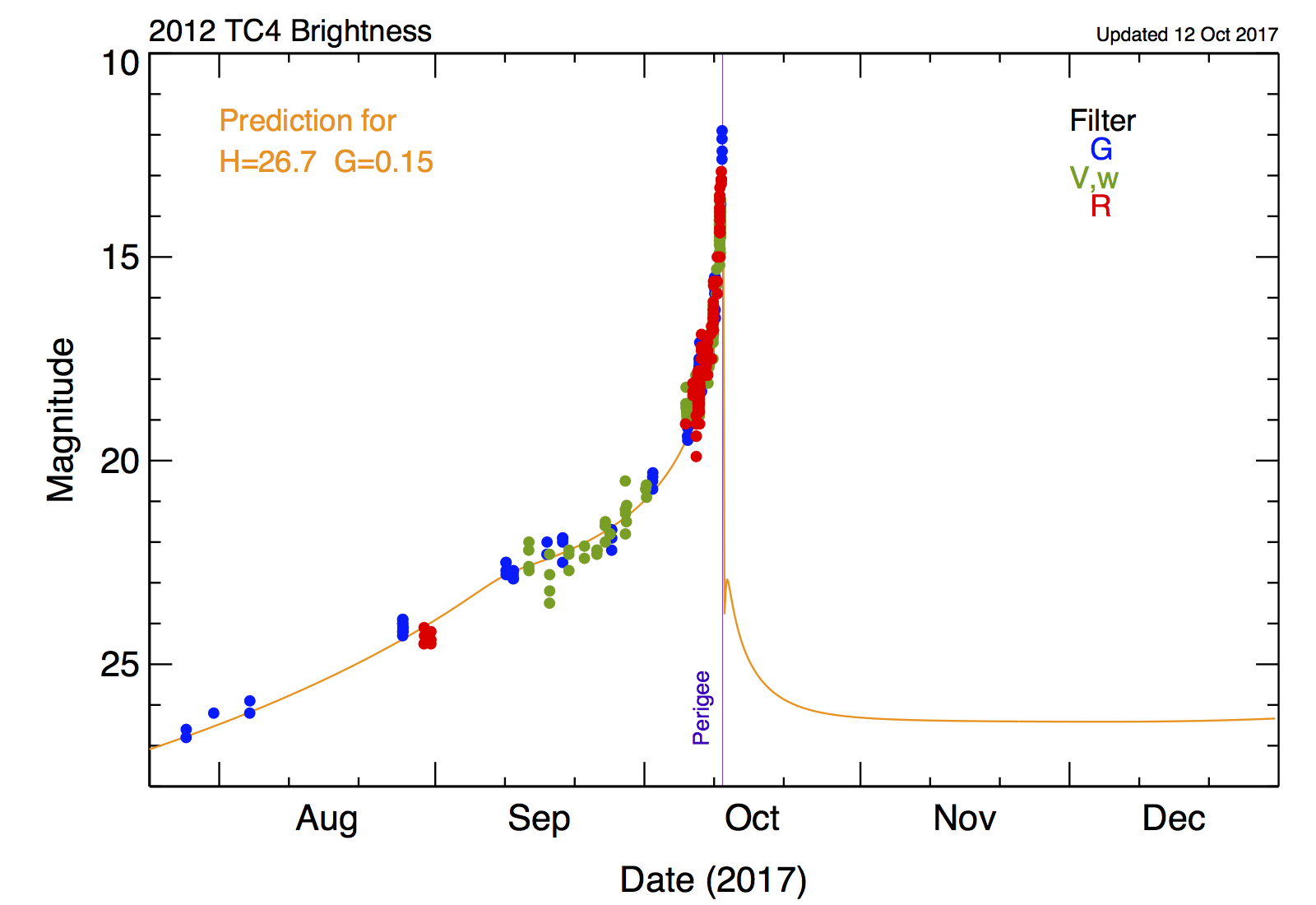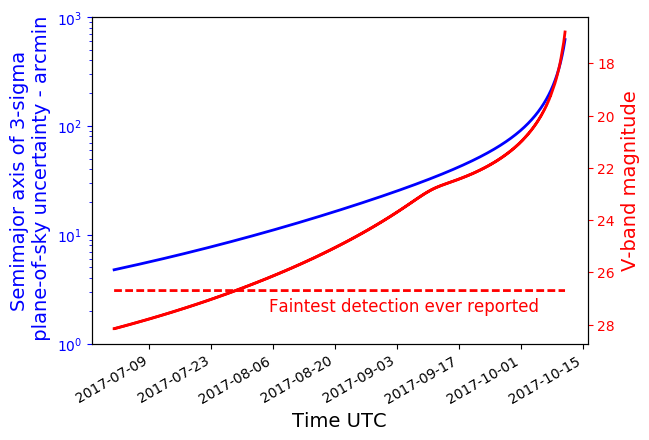What's going on with NEA 2012 TC4?
Current Lightcurve

PDF Version
Data (MPC database)
Status Updates
2019.06.21: The supplemental lightcurve data from Reddy et al., 2019 is available.
2017 Oct 16: New orbit solution precludes any Earth impact for the next 100 years. Orbit solution JPL#56, which included radar astrometry and close encounter optical data, has ruled out any impact with the Earth in the next 100 years. As of 16 Oct 2017, 2012 TC4 has been removed from the Sentry: Impact Monitoring List.
2017 Oct 13: The new solution (#56) on SBDB and Horizons uses the close approach optical observations and the additional astrometry from MRO on the 13th. Many stations showed obvious along-track biases, probably caused by clock errors, and were therefore not included in the fit. With this solution, which is very much consistent with the previous ones, we have entered the reconstruction mode.
The close approach estimates and 3-sigma uncertainties are:
- Distance from the geocenter: 50151.40 ± 0.39km
- Time of close approach: 2017-10-12 05:40:50.475 UTC ± 0.017s
2017 Oct 11: Another movie showing the asteroid's motion across the sky is given here. It was obtained by Ryou Ohsawa and collaborators at the Kiso observatory in Japan on Oct. 10 and 11, using a newly developed CMOS camera. This movie also shows the asteroid getting brighter and fainter as it traverses the sky.
2017 Oct 11: A movie showing 2012 TC4 has been posted on the Gallery web page. It was obtained by Alberto Quijano Vodniza and Mario Rojas Pereira, University of Narino Observatory, Colombia, and clearly shows the asteroid getting brighter and fainter as it traverses the sky.
2017 Oct 11: The final orbit solution before close approach (JPL#55) remains stable, giving a close approach distance of 50,151.6 ±1.1 km and time of close approach 2017-10-12 05:40:50.464 ±0.03s UT.
2017 Oct 10: Observations are ramping up with additional astrometry measurements, including three radar doppler measurement have been obtained. The current orbit (JPL#54) narrows the uncertainties significantly, giving a close approach distance of 50,151.6 ±1.6 km and the estimated time of close approach 2017-10-12 05:40:50.44 ±0.15s UT.
2017 Oct 10: Observations are ramping up. 62 additional astrometry measurements, including a radar doppler measurement have been obtained. The current orbit (JPL#52) gives a close approach distance of 50,151.3 ±3.3 km and the estimated time of close approach 2017-10-12 05:40:49 ±7s UT.
2017 Oct 9: Additional astrometry has been received from GiaGa Observatory (Oct 6), iTelescope Observatory, Nerpio (Oct 6), and Magdalena Ridge (Oct 7). The current orbit (JPL#50) gives a close approach distance of 50,151 ±6 km and the estimated time of close approach 2017-10-12 05:40:45 ±12s UT.
2017 Oct 3: Additional astrometry has been received from Terksol (Sep 20, 22 & 25), SRO Observatory (Oct 1), and Magdalena Ridge (Oct 2). The current orbit (JPL#48) gives a close approach distance of 50,151 ±11 km and the estimated time of close approach 2017-10-12 05:40:44 ±12s UT.
The orbit solution now precludes an Earth impact in 2050. See Orbit page for more details.
2017 Sep 29: Two new 2012 TC4 lightcurves were measured by Palomar 200-inch and Mayall 4M observers.
A description of the Palomar 200-inch results from Sept. 17 and 20, 2017 (posted Sep24) can be seen here, and the photometry data can be obtained here.
The Mayall 4 Meter results from Sept. 13 and 14, 2017 (posted on Sept. 28) can be seen here.
Both lightcurves exhibit the complex rotation signature seen during the 2012 discovery Earth close-approach, with a primary period approximately 12.25 minutes. Observers Brucker, Scotti and McMillan found a period of 12min 15sec, and observers Kramer (at telescope), Bauer, Masiero and Bozovic found a period of 12min 16sec in the preliminary reduction.
2017 Sep 29: Additional astrometry has been received from PanSTARRS (Sep 25 & 28), Cerro Tololo (Sep 26), Magdalena Ridge (Sep 26) and Catalina (Sep 28). The current orbit (JPL#46) gives a close approach distance of 50,153 ±15 km and the estimated time of close approach 2017-10-12 05:40:52 ±18s UT.
2017 Sep 26: Astrometry received from ARO Westfield (Sep 24). The current orbit (JPL#42) continues to give a close approach distance of 50,164 ±31 km and the estimated time of close approach 2017-10-12 05:40:54 ±19s UT.
2017 Sep 22: Astrometry received from ARO Westfield (Sep 20). The current orbit (JPL#40) gives a close approach distance of 50,164 ±34 km and the estimated time of close approach 2017-10-12 05:40:54 ±20s UT.
2017 Sep 21: Astrometry received from LCOGT (Sep 19) and OGS (Sep 20). The current orbit (JPL#38) gives a close approach distance of 50,165 ±35 km and the estimated time of close approach 2017-10-12 05:40:54 ±20s UT.
2017 Sep 18: Astrometry received from Subaru (Aug 27), Pan-STARRS (Sep 14 & 17) and OGS (Sep 17). The current orbit (JPL#36) gives a close approach distance of 50,168 ±40 km and the estimated time of close approach 2017-10-12 05:40:55 ±20s UT.
2017 Sep 15: PanSTARRS has provided further astrometry from Sept. 14, UT. The current orbit (JPL#34) gives a close approach distance of 50,179 ±66 km and the estimated time of close approach 2017-10-12 05:40:56 ±22s UT.
2017 Sep 12: Bill and Eileen Ryan of Magdalena Ridge provided further astrometry from Sept. 12, UT. This produced only a small change on the orbital geometry (JPL#32) with a close approach distance of 50,174 ±70 km and the estimated time of close approach 2017-10-12 05:40:56 ±22s UT.
2017 Sep 11: Bill and Eileen Ryan of Magdalena Ridge provided further astrometry from Sept. 11, UT.
Orbit solution JPL#30 is now available and includes these observations. It also contains nongravitational perturbations on 2012 TC4 (Yarkovsky drift and radiation pressure). Although the astrometry is not yet accurate enough to detect these effects, the trajectory uncertainty has decreased to the point that they may soon be measurable.
The orbit update had little effect on the approach geometry, though it did reduce the uncertainties. Close approach distance is 50,169 ±83 km and the estimated time of close approach is 2017-10-12 05:40:55 ±23s UT. Uncertainties are 3-sigma.
2017 Sep 05: Today the MPC published new observations of 2012 TC4 that Bob McMillan obtained at Kitt Peak on Aug 30 and 31. JPL solution 28 is now available on the JPL Small-Body Database and Horizons and includes these new observations, which further reduce uncertainties for the October close approach.
The estimated close approach distance is 50170 km with a 3-sigma uncertainty of ±230 km and the estimated time of close approach is 2017-10-12 05:40:55 UT with a 3-sigma uncertainty of ±35 seconds.
As a side note, the impact probability for 2050 has increased to 2/1000. Hopefully the data collected during this campaign will allow us to rule out the impact!
Recovery Status
6 August 2017: [Recovered] Owing to the latest VLT observations by O. Hainaut, D. Koschny, and M. Micheli, 2012 TC4 is now recovered! Initial observations of a potential object found on July 27, 2017 were confirmed on July 31 and August 5, 2017. The JPL small database browser now posts the close approach distance for 2017 Oct. 12 as 0.000335 AU (~50100 km) based on the addition of M. Micheli's and O. Hainaut's astrometric measurements, and the object's H-magnitude value is near 26.7, corresponding to a diameter of around 15 meters for an object with an albedo of about 15%. The recovery's Minor Planet Electronic Circular is here .
28 July 2017: [Still unobserved] Currently, the asteroid has not been recovered on its 2017 apparition, though with a predicted mag >26, it was not expected to have been seen yet. As shown in the plot below, it is expected to become bright enough in the next couple weeks to be recovered. The plot also shows the size of the current positional uncertainty, and how its apparent size projected on the sky will change until the asteroid is recovered.

